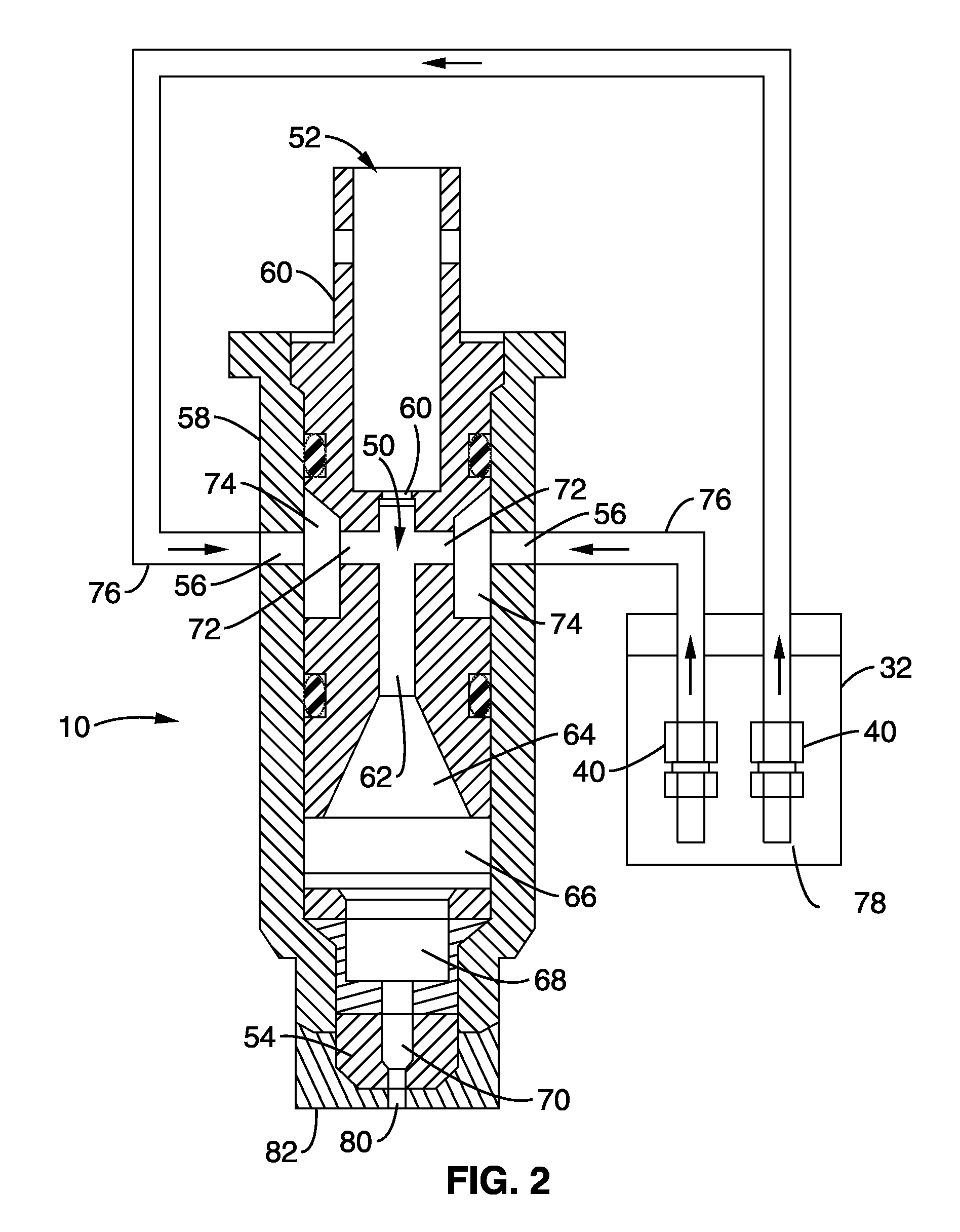System and method for at-nozzle injection of agrochemicals
a technology of at-nozzle injection and agrochemicals, which is applied in the direction of electrochemical generators, transportation and packaging, liquid transfer devices, etc., can solve the problems of poor crop yield, adverse environmental injuries, and ineffective application, and achieve the effect of increasing costs, improving the yield of crops, and improving the effect of application
- Summary
- Abstract
- Description
- Claims
- Application Information
AI Technical Summary
Benefits of technology
Problems solved by technology
Method used
Image
Examples
example 1
[0088]The nozzle used in this example was a 110 degree fan angle, Venturi flat fan nozzle (AI 11004, TeeJet, Spraying Systems, Inc.). Inserted into the two air inlet ports of the integrated Venturi were barbed connectors leading to 50 cm of plastic tubing (1.6 mm i.d.). The plastic tubing terminated into a standard threaded nozzle body assembly (CP1322 ¼TT, TeeJet, Spraying Systems, Inc.) into which a range of orifice metering plates were installed. The metering plates were standard commercial components (CP 4916 Series, TeeJet, Spraying Systems, Inc.) with orifice diameters of 0.20, 0.38, 0.76, 1.54 and 3.05 mm (Plate Nos. 8, 15, 30, 61 and 120, respectively, Spraying Systems, Inc.). The carrier liquid, supplied to the liquid inlet of the nozzle, for all experiments was de-ionized water and the injected liquids, supplied to the air induction ports, were de-ionized water, a 0.25% v / v surfactant solution (Triton X-100, Fisher Scientific) in de-ionized water and a 0.25% v / v polymer so...
example 2
[0100]In this example an array of 6 nozzles was fabricated in a linear spray boom with 20 inches between each nozzle. A system of spray collectors was devised to capture the emitted spray on a plane 20 inches below the exit tips of the spray nozzles. The spray discharge was collected in 1.5 inch increments along the plane. This provided a measure of the uniformity of the spray mix along the entire 120 inch spray pattern created by the 6-nozzle spray boom. Salt tracer was added to the injected fluid as discussed in Example 1. The measurement techniques used in Example 1 were also used for this example.
[0101]The system was fabricated as illustrated in FIG. 1. The nozzles were AI 11008 nozzles (Spraying Systems, Inc.) and operated at a carrier liquid pressure of 2 bar. In the first set of tests, the nozzles were configured similarly as shown in FIG. 2 with an injection line directed to each side of the Venturi inlet. The test orifices were Nos. 10, 20 and 41 as described in Example 1.
[...
example 3
[0105]It is desirable to have an active control over the flow rate of the injected liquid into the Venturi passage in the nozzle. This would provide a means for adjusting the application rate of active ingredient contained in the injected liquid. In this example, the system shown in FIG. 1 was tested. A controllable needle metering valve was used to alter the injection rate of liquid into the nozzles. A No. 41 metering orifice plate was installed as orifice plate assembly.
[0106]In the first test, 6 AI 11008 nozzles were operated as described in Example 2. Spray tracer fluid was used as in Example 2. However, rather than manually changing the orifice plates to adjust injection flow rate, the needle valve was manually closed until the flow rate on flowmeter was observed to match that obtained then orifice plates 10 and 20 were installed at location.
[0107]The results are shown in FIG. 15. Injection rates and resulting spray concentrations equivalent to those achieved by replacing the m...
PUM
 Login to View More
Login to View More Abstract
Description
Claims
Application Information
 Login to View More
Login to View More - R&D Engineer
- R&D Manager
- IP Professional
- Industry Leading Data Capabilities
- Powerful AI technology
- Patent DNA Extraction
Browse by: Latest US Patents, China's latest patents, Technical Efficacy Thesaurus, Application Domain, Technology Topic, Popular Technical Reports.
© 2024 PatSnap. All rights reserved.Legal|Privacy policy|Modern Slavery Act Transparency Statement|Sitemap|About US| Contact US: help@patsnap.com










